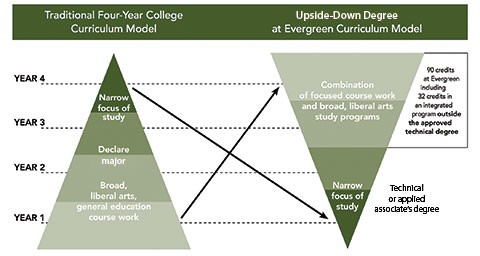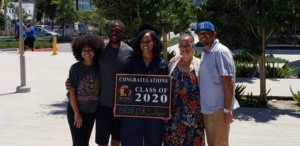America: Abandon Your Reverence for the Bachelor’s Degree

Going to college was a BIG deal in my family. Both of my grandfathers went on the GI Bill after WWII, and both of my parents graduated too. I remember going to school as an Oregon Duck football player for Halloween, and visiting college campus’ while on family road trips (everywhere from USC to Notre Dame, Kent State to UVA). For me, after high school was college, and the traditional pathway was the only way I knew.
But after enrolling in three different universities by the time I was a sophomore, I realized that maybe going immediately to college after high school wasn’t working for me. I began to rethink college. Thankfully, I had the family, friends, and financial support to grind it out. But for many students, especially low-income students, those supports aren’t there. Yet these students know that a four year degree is their bridge to financial security and a door to the idea economy.
In this blog that first appeared in The Atlantic, Mary Alice McCarthy shares the stories of how her nephews navigated heavy HigherEd decisions and how the postsecondary landscape is being spurred by innovations like Bachelor’s of applied science options, a four-year degree that builds on a two-year technical degree at a community college that provides a seamless pathway for students pursuing a bachelor’s, who might see the value of spending the beginning of their college career on technical skills instead of the the traditional two-year general-education requirements.
Mary Alice McCarthy
Two years ago, my nephew was set to graduate from Maryland’s Towson University with a degree in political science. After six long years, both he and his parents were ready to breathe a sigh of relief—he had made it to the finish line. He had never been excited about school, and his parents had worried about his lack of enthusiasm, wishing he could be engaged in something that ignited his curiosity and provided him more of a motivation to focus, something more hands-on and practical. But they also knew that without a bachelor’s degree, my nephew’s ability to move into a rewarding career, earn a middle-class salary, and enjoy some economic security would be very limited. And they worried that if he didn’t complete that degree before he turned 25, he likely never would (a reasonable concern, given national statistics on college completion). Determined to launch him into adulthood with the strongest possible foundation they could, they persuaded him to go to college and crossed their fingers.
They knew their son well. In fact, he was not burning the midnight oil in the library. As graduation day approached, all three of them were greeted with an unwelcome reminder of his distracted approach to school; my nephew could not march that spring because he was still three credits shy of the requirement. Holding up their son’s transcript, his adviser pointed out that he had taken the same economics course twice—one year apart. My nephew hadn’t noticed. When his exasperated parents demanded an explanation, all he could offer up was that the class had been taught by a different professor, and held in a different room. He got a B both times around.
He eventually completed his degree, but is currently unemployed and living at home, and his life in the two years since he graduated has been a collection of dismal white-collar jobs—in a call center chasing down delinquent customers for Baltimore Gas and Electric, and a law firm processing home foreclosures. He longs for the days when he was delivering pizzas. (He asked not to be named in this story, because he’s sensitive about publicizing the details of his education and employment.)
Another nephew of mine, Jeffrey, faced a similar dilemma, but took a different route. Although bright and curious, Jeffery had little interest in academics and could not wait to leave high school behind him—not because he lacked ambition or big dreams, but because he was far too restless to sit around for another four years. Jeffrey knew that he was not likely to succeed in traditional college. So after high school, he pursued his passion for cooking and enrolled in an apprenticeship program in culinary arts at Milwaukee Area Technical College. He was there for three years, during which time he spent one day a week in the classroom and four days in an Italian restaurant that sponsored him as an apprentice, working directly under the mentorship of the head chef and earning money along the way. The program was highly structured, hands-on, and designed to teach specific skills—menu planning, portions and measurements, cost control, customer service, basic nutrition, sauces, and so on. At the age of twenty-two, he graduated with the status of “journeyman cook” and a formal certificate of completion.
Following his dream, Jeffrey promptly moved to New York, pounding the pavement of lower Manhattan, resume and recommendations from his mentors in hand. In short order, he landed a job as a line chef at Laconda Verde, an Italian restaurant owned by Robert De Niro. Two years later he moved to Del Posto, a Michelin-starred restaurant run by the celebrity chef Mario Batali. He continued developing his culinary skills, while also learning about the restaurant business and nurturing newfound interests in Italian history, wild foods, organic farming, and urban living. It was a bold move for a young man from suburban Milwaukee, the kind of move that expands horizons and builds an understanding of how the world works. That’s certainly a lot better than dropping out of college, the most likely outcome had he gone the more traditional route.Unfortunately for Jeffrey, however, it’s very hard to make a decent living as a cook, even in the best restaurants of New York. So after three years of hard work and great experience but very little money, he decided he was ready for a change and moved back to Milwaukee. He quickly discovered that without a bachelor’s degree his ability to get any job other than cooking was going to be tough. But older, wiser, and a little bit calmer, he was ready to consider getting a bachelor’s degree. That is, until he looked into it and discovered that he would have to start completely from scratch. None of the courses he completed at MATC would transfer to a four-year school. After three years in a college-based apprenticeship program and three years of solid work experience, he was still the equivalent of a brand-new high-school graduate in the eyes of higher education.
Jeffrey is currently working as a sous chef at an Italian restaurant in downtown Milwaukee. He is enjoying being higher up in the kitchen food chain than he was in New York, but the prospect of earning a true middle-class salary, the kind you can raise a family on, seems impossibly distant to him. If he had a bachelor’s degree, he would have a better shot at more remunerative jobs in, say, food-service management—half of all such jobs now require a B.A., and food service managers with a B.A. or more earn $20,000 more a year than such managers with an associate’s degree or less, according to the Georgetown Center for Education and the Workforce. He’d also love to someday open his own restaurant, a risky proposition for which the experience and connections that come from managing restaurants is almost a necessity. But the thought of starting a B.A. from scratch leaves him deflated. Four years is still just too long.The traditional higher-education system works great for lots of students. But it forces countless others, like my nephews, to choose between two bad options: either enter a four-year bachelor’s degree program for which they are not ready, academically or emotionally; or pursue some kind of job-focused training program that, while valuable, may effectively put a ceiling on their careers.It’s a dilemma millions of middle- and upper-middle-class families know well, but it’s even worse for working-class and poor families. At the end of the day, one of my nephew’s parents could afford to pay for a four-year degree, even if they knew a lot of the coursework would wash over their son. But for many low-income students, spending four years in school before even starting a career is not an option. That’s part of the reason why so many low-income students end up in technical training programs—not because they are not interested in earning a bachelor’s degree, but because they need to earn a decent income along the way. Many of those technical programs lead to good-paying jobs. What they don’t lead to is a bachelor’s degree. And without a B.A., there is only so far you can reasonably expect to rise in this country.
The lack of good options for my nephews and students like them up and down the income scale is not inevitable. It’s possible to envision a better option, one that rejects the false and damaging logic that job training and experience must always come after, not before, academic training. In fact, some colleges are experimenting with alternative “upside-down” degrees, in which students who choose job training and work experience right out of high school aren’t getting onto an educational dead-end road but, rather, onto a bridge that can lead, with a little more schooling, to a bachelor’s degree. But for these alternatives to become widespread, higher education will have to rethink some unquestioned—and highly questionable—assumptions about what a B.A. is or should be.
Training is widely understood to be the end, not the beginning, of an educational journey that leads to a particular job or career.
If you ever need to strike up a conversation with a group of academics, a surefire way to get them talking is to ask about their graduate training. Where did they train, in what methods, in which lab, under what mentor? People will speak with great pride about their training as an economist, historian, chemist, philosopher, or classicist. If, on the other hand, you need to make a quick exit, try sharing the opinion that undergraduate education should include a lot more vocational training. You’ll soon find yourself standing alone or responding to accusations of classism and questions about your commitment to social and racial equality. You might even hear that “training is for dogs,” a common refrain in higher education that carries the unpleasant implication that skills-based education is the equivalent of teaching students to sit, stay, and shake hands.
For reasons that are not entirely clear, in the United States training is widely understood to be the end, not the beginning, of an educational journey that leads to a particular job or career. Undergraduates are supposed to get a general education that will prepare them for training, which they will presumably get once they land a job or go to graduate school. Any training that happens before then just doesn’t count.
It is because of this belief that general-education requirements are the center of the bachelor’s degree and are concentrated in the first two years of a four-year program. The general-education core is what distinguishes the B.A. from a vocational program and makes it more than “just training.” It is designed to ensure that all degree holders graduate with a breadth of knowledge in addition to an in-depth understanding of a particular subject area. Students are exposed to a broad range of disciplines and are pushed to think critically about the social, cultural, and historical context in which they live. It is supposed to guarantee that all graduates can write, have a basic understanding of the scientific method, have heard of the Marshall Plan and Maslow’s hierarchy of needs, and know that iambic pentameter has something to do with poetry.
While few would challenge the importance of general education, both to students and to a well-functioning democracy, there is good reason to question why it has to come at the beginning of a B.A.—and just how general and theoretical it needs to be. The pyramid structure of the bachelor’s degree, which requires that students start with the broad base of general requirements before they specialize, is what makes college unappealing to so many young people.
It doesn’t have to be this way. There is no iron law of learning dictating that students must master general theories or be fully versed in a particular historical or cultural context before learning how to do things. Some students will do well under this approach, but there is solid evidence that some students learn better through experience. For these students, theory does not make sense until it is connected to action. Putting a lot of general or theoretical courses on the front end just leaves them disengaged or, even worse, discouraged. They will do better if they start by learning how to master certain tasks or behaviors and then explore the more abstract concepts behind the actions.
State and community colleges in the state of Washington figured this out years ago and offer a variety of options for students who want to begin their college career with technical training. Evergreen State College allows students to earn an upside-down bachelor’s degree, with the technical education coming first, followed by two years of broader, general education. The program is designed for students like Jeffrey, with a more flexible approach to learning that honors the purpose of the general-education requirements more than a rigid set of rules around exactly how many credits a student must have to graduate, and when. Under this approach, students can use the last two years of college to round out their education with courses designed to give them a broader understanding of the historical and social context in which they live and work, along with addressing any gaps in writing, analytical, or math skills. For many students who have been out in the world working and applying their skills already, the opportunity to pull back and see the big picture can be very appealing.

Other community colleges in Washington offer a bachelor’s of applied science, or BAS, a four-year degree designed explicitly to build on a two-year technical degree and provide a seamless pathway for students to continue their education. Some of the programs, like the BAS in manufacturing operations at Clover Park Technical College, add business and management skills to a two-year program teaching students how to operate and repair complex machinery. Others, like the BAS in radiologic technology at Bellevue College, allow students to continue deepening their technical skills in a particular field.
For some students, theory does not make sense until it is connected to action.
The programs are still relatively new, but early outcome data is encouraging. According to a 2014 impact evaluation, 75 percent of graduates were employed two years out, with average earnings ranging from more than $80,000 for graduates of the radiology programs to $27,000 for those earning an applied-management degree, with an average of $37,000 across all programs—comparable to the earnings of students graduating with traditional four-year degrees. Some students had transitioned successfully into graduate programs. The BAS degree is proving popular and growing: since 2010, when the degrees were first launched, enrollments have gone from just over a hundred students to nearly 1,000 in 2014. The colleges are planning for continued growth.
The new degrees are not without their critics. One rap against them is that they reinforce the notion that everyone must earn a bachelor’s degree to be successful, unnecessarily prolonging time in school. It is certainly true that some technical degrees and certificates below the bachelor’s degree generate impressive outcomes. Recent research by Mark Schneider of AIR showed that students in Texas and Colorado with one- and two-year certificates in applied engineering fields often out-earn their counterparts with bachelor’s degrees and sustain that advantage even ten years out. But it is also true that, on average, people with bachelor’s degrees fare better than their counterparts on just about every measure that matters: they earn more money, are less likely to be unemployed, and like their jobs better. Bachelor’s degree holders are simply better positioned to weather recessions, execute career transitions, acquire new skills with the support of their employers, and be promoted. While a bachelor’s degree is far from a guarantee of career success or economic security today, it is still the best insurance against poverty and insecurity that one can get. And the gap between BAs and quicker-to-get diplomas is growing. According to the Pew Research Center, in 1965 the earnings difference between young adults (ages 25-32) who earned a B.A. degree and those with a two-year degree or some college was about $5,000. By 2013, the difference had grown to $15,000, with the real earnings of the some-college/two-year degree group falling from $33,655 to $30,000 (in 2012 dollars).
Other skeptics worry that a new crop of degree options will just dilute the value of the B.A. even more—and this is a valid concern. The explosive growth of vocational programs at community and for-profit colleges over the last two decades should definitely give us pause. There is clearly strong demand for programs that promise to lead directly to jobs—the number of vocational certificates awarded by colleges doubled between 2001 and 2011—and while we know that many of these programs generate good outcomes for students, we also know that a large number of them are of very poor quality and leave students with unmanageable debt and rotten employment prospects. The ubiquity of the programs is also playing a role in the relentless credential creep that is driving up the educational requirements for jobs like administrative assistance and bookkeeping. Today, there are many schools that offer one-year certificates in dental hygiene. There are also programs that offer a two-year associate’s degrees in dental hygiene. Now, some schools have even started offering a bachelor’s of applied science in dental hygiene. And the differences among these are difficult to discern. Policymakers—state education agencies and accreditors—need to ensure that BAS degrees do not simply provide a way for colleges to stretch out programs that do not really require four years of education.
Neither of my nephews was well served by a higher-education system that is too rigid to meet their needs. Both could have used an opportunity to learn in a more engaged, hands-on style, enabling them to develop concrete skills and apply them in the real world. While those alternatives exist, too often we penalize students who choose a training program right out of high school, sending them down educational dead-ends.
In the case of my nephew who earned a B.A., he and his family spent tens of thousands of dollars on an education that took many years but has left little mark. He got that four-year degree, and all of the long-term advantages that come with it, but one can’t help wondering what other activities might have filled those six years of bored meandering in college repeating courses. What else could he have been doing that would have left him more fulfilled, motivated, and excited about the future?
In Jeffrey’s case, he has some solid skills and great experience under his belt, as well the confidence that comes with mastering a trade, but his future is constrained.
It is often said in the United States that no member of Congress or leading CEO started their career in a community-college technical-training program—pathways to positions of leadership start with a bachelor’s degree. Is this true because graduates of technical-training programs are not fit to become leaders, or because we don’t allow them to? Try saying the same thing to someone in Germany, Austria, or Switzerland. Many politicians, senior managers, and even CEOs have come up through those countries’ impressive vocational-training systems. The issue isn’t that a career that starts with technical training can’t lead to more advanced learning and skills. It is that our higher-education policies simply don’t allow for it—and that’s just a failure of imagination.
For more, check out:
- 5 Options Allow GenDIY to Rethink College
- Southern New Hampshire Reshaping Higher Ed Landscape
- The Campus of the Future: Hybrid and Lean
Mary Alice McCarthy is a Senior Policy Analyst at New America Foundation. Follow Mary Alice on Twitter, @McCarthyEdWork.
Stay in-the-know with all things EdTech and innovations in learning by signing up to receive the weekly Smart Update.





Witness
At median, US grads rank only 12th of 16 for math. Typically (per the WSJ) foreign languages, economics, even history, aren't core subjects. It is a national disgrace.